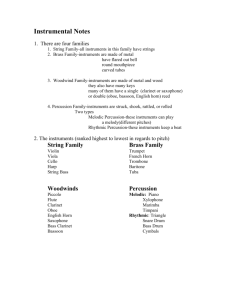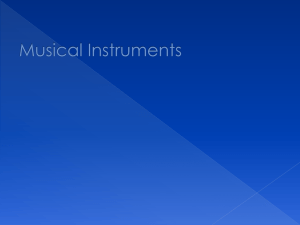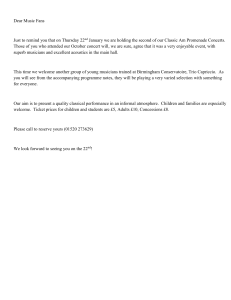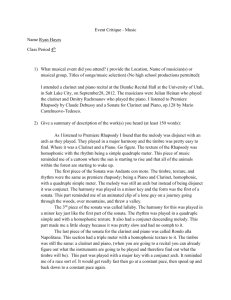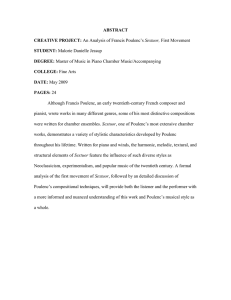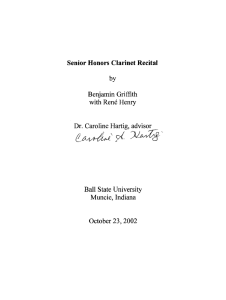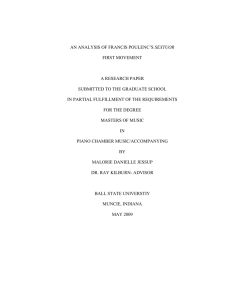•
advertisement
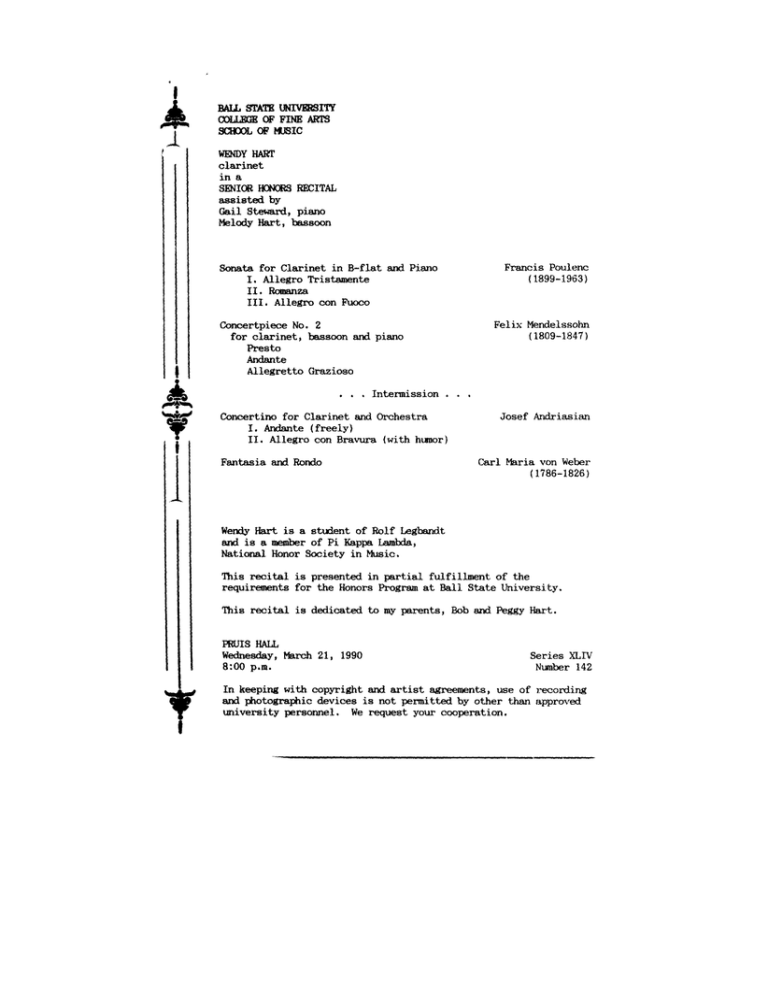
I • -1 BALL STATE UNIVBRSITY CC>I..L"mB OF FINE ARTS SCHX>L OF f«JSIC WENDY HARl' clarinet in a SENIOR HOOOOS RECITAL assisted by Gail S~, piano Melody Hart, bassoon Sonata for Clarinet in B-flat and Piano I. Allegro Tristamente Francis Poulenc (1899-1963) II.Romanza III. Allegro con Fuoco , ~ "1 Concertpiece No. 2 for clarinet, bassoon and piano Presto Andante Allegretto Grazioso Felix Mendelssohn (1809-1847) . Intermission Concertina for Clarinet and Orchestra I. Andante (freely) II. Allegro can Bravura (with humor) Josef Andriasian Carl Maria von Weber (1786-1826) Fantasia and Rondo Wendy Hart is a student of Rolf Legbandt and is a member of Pi Kappa Lambda, National Honor Society in Music. This recital is presented in partial fulfillment of the requirements for the Honors Program at Ball State University. This red tal is dedicated to my parents, Bob and Peggy Hart. FRUIS HALL Wednesday, March 21, 1990 8:00 p.m. Series XLIV Number 142 In keeping with copyright and artist agreements, use of recording and photographic devices is not permitted by other than approved tmiversity personnel. We request your cooperation. ------------------------------------------------- Program Notes Wendy Ann Hart Senior Honors Recital March 21, 1990 8:00 pm Sonata for Clarinet in Bb and Piano (1962) I. Allegro Tristamente II. Romanza III. Allegro con Fuoco Francis Poulenc (1899-1963) Poulenc was a French pianist and a self-taught composer. Even so, he has been considered one of France's most brilliant. He was a member of "Les Six," a group of progressive French musicians that was characterized by its members' avoidance of Romantic style of writing. Poulenc's style, in particular, can be described as sophisticated and urban. - The Sonata, Poulenc's last composition, was written in 1962 and is typical of his late works. The title "sonata" is typically reserved by composers for their most serious essays in duo or solo instrumental music, and this piece is no exception. It follows the typical three-movement sonata formula used by late 18th Century composers. Concertpiece No. 2 (1833) for clarinet, bassoon and piano Presto Andante Allegretto grazioso Felix Mendelssohn, Op. 114 (1809-1847) Mendelssohn was a German composer who, although he grew up surrounded by Romantic influences, gained his inspiration chiefly from the Classical style. Robert Schumann called Mendelssohn the "Mozart of the nineteenth century." During January of 1833, Mendelssohn wrote two Concertpieces for clarinet, basset horn (or bassoon) and piano. The pieces were written for virtuoso clarinetist, Heinrich Barmann, and his brother Carl Barmann, the bassoonist with the Royal Orchestra in Berlin to whom this piece was also dedicated. Concertino for Clarinet and Orchestra I. Andante (freely) II. Allegro con Bravura (with humor) Josef Andriasian, Cp. 13 This is the American premiere performance of Andriasian's Concerti no. The piece was composed and first performed in the Soviet Union. After hearing the piece, Soviet musician, Dimitri Sitkovetski who was serving as an Artist in Residence at Ball State brought a copy to this country which he gave to Mr. Legbandt. The first movement consists of a freely flowing clarinet melody over a characteristically contemporary accompaniment containing improvised and aleatoric (chance) passages. The second movement is essentially rhythmic and allows for interplay, and even canon, between the two voices. Fantasia and Rondo (1815) Carl Maria von Weber, Op. 34 (1786-1826) arr. Gustave Langenus Carl Maria von Weber was an important founder of the Romantic movement in Germany. He originally composed this work for clarinet and string quartet. Later, Gustave Langenus arranged two movements of this Grosses Quintet for clarinet and piano. The Fantasia, which means "fantasy" or "fancy," is a piece without fixed form which allows the composer to follow the dictates of his imagination. The Rondo, on the other hand follows a strict formal structure in which one section recurs between contrasting sections known as episodes. This form is commonly used for the final movement of chamber works written during this period. Around 1811, Weber met Heinrich Barmann, the same man for whom Mendelssohn's Concertpieces were written. The two went on tour together and as a result, there are many fine works for the clarinet written by Weber.

